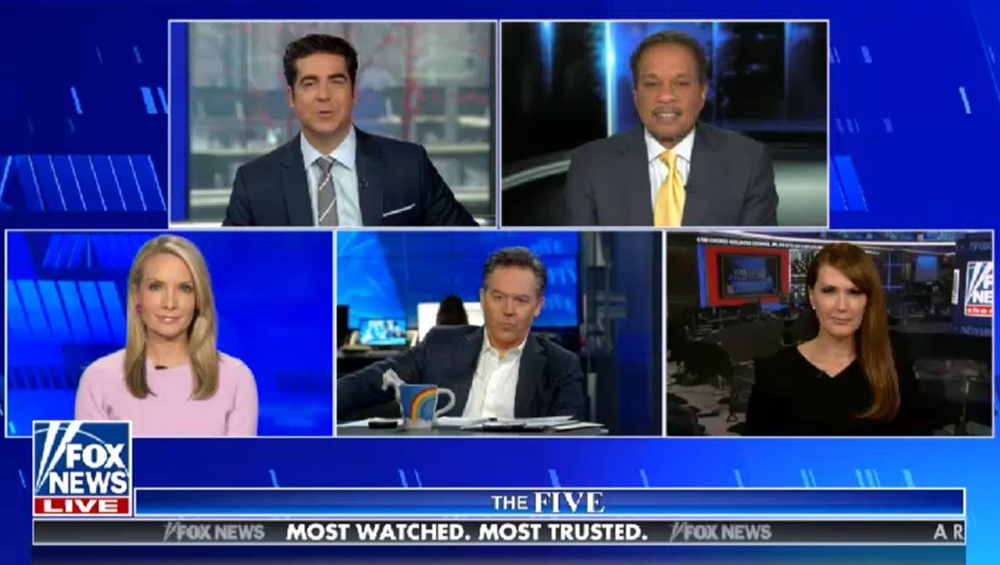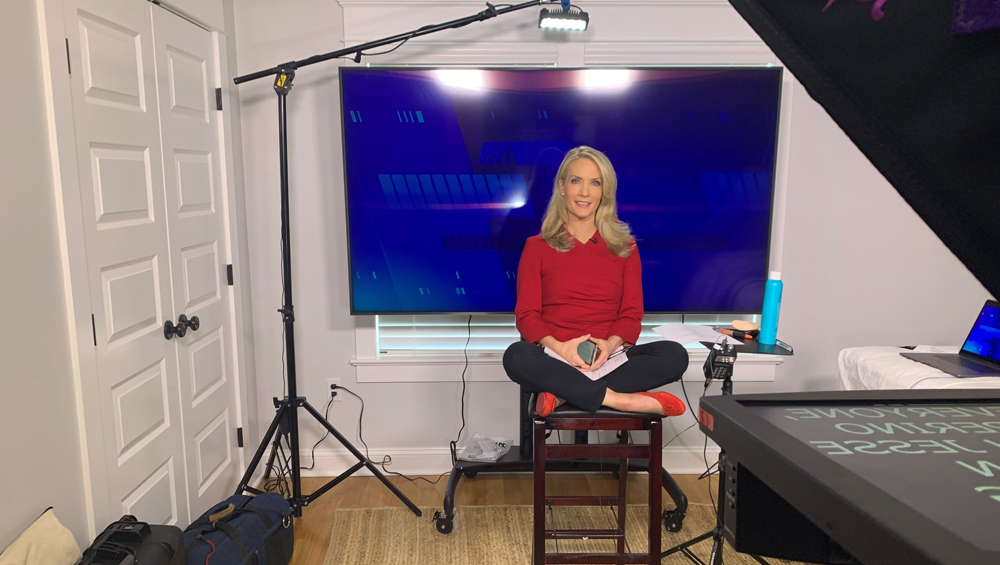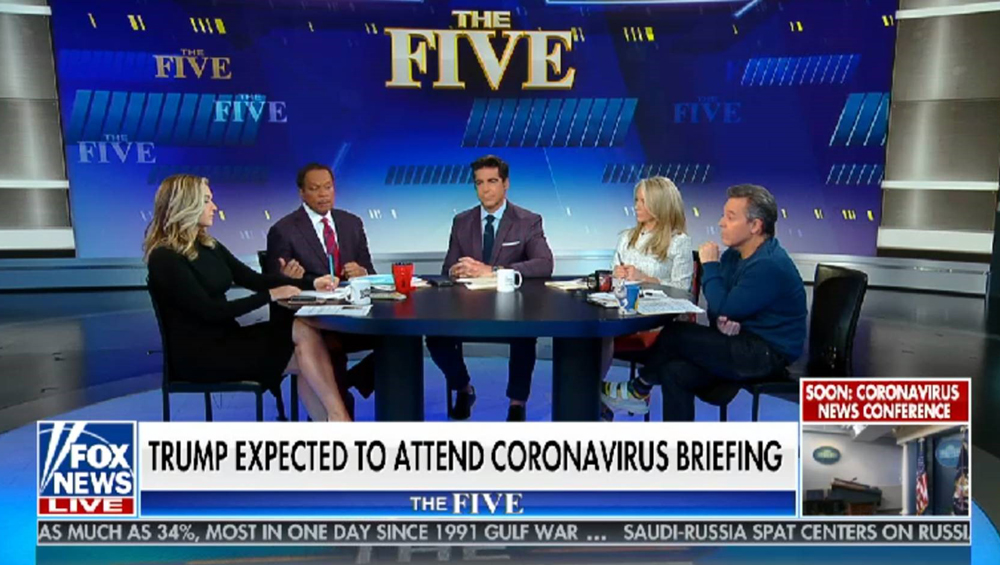
Fox News’ ‘The Five’ Versus Social Distancing

When Dana Perino shifted from politics to punditry, she got an early lesson in what makes a good panel show tick.
Perino served as press secretary for President George W. Bush before segueing to Fox News as one of the inaugural hosts of The Five in 2011, “but when I was press secretary, I never really understood the importance of chemistry for a panel show,” she says. “Once I started doing it, I realized how important it was, and we seem to have kind of a magic formula for our show.”
Helping to alchemize that formula are her three permanent co-hosts, Greg Gutfeld, Juan Williams and Jesse Watters, along with a rotating fifth person. Five afternoons a week they sit at a table and spar over the day’s political news from across the ideological spectrum.
Until last month, that is, when the show shifted into semi-remote production out of coronavirus-induced necessity. First, hosts were distanced two at a desk in two separate studios on different floors in Fox’s New York headquarters. The odd man — or woman — out patched in from yet another camera placed on a different floor.
That lasted a week until the pandemic’s severity became clearer and production conditions changed again. This time, Gutfeld and Watters stayed in the building in separate studios. Perino and Williams were dispatched home with remote setups. The fifth, rotating host has joined either from elsewhere in Fox’s building or a remote home setup, depending on the person.
All of which took a show predicated on interpersonal dynamics and cut it into five disjointed pieces.

Dana Perino in her guest bedroom/studio.
Perino, who hosts Fox’s The Daily Briefing earlier each day from a guest bedroom in her Bay Head, N.J., home as well, admits the new arrangement has created challenges. The most irritating of them is the loud and overzealous whistle of a local commuter train at exactly 20 minutes after each hour.
The most serious challenge impacts the show’s chemistry. For one thing, she can no longer look at the faces of her co-hosts.
“There is a return monitor, but if you are looking at that you are not looking at the camera,” she says. “If the director is taking a shot of all five of us at the same time, you don’t want to be looking off to the side.”
Then there’s the crosstalk issue. Getting cable news show panelists not to talk over each other is like asking fish not to swim. Alas, remote production’s inherent latency — usually at least a second — makes for some awkward beats.
“It’s hard not to step on each other a little bit if you want to make a point and everybody is talking at once,” Perino says.
Megan Albano, executive producer of both The Five and The Daily Briefing, also concedes that latency is hard on a panel show. “There is a delay for people that are on remote versus the people that are in the studio, so you lose a little bit of the natural flow of a conversation,” she says.
“If Greg asks [Dana] a question, we have a little two-second delay waiting for her to respond,” Albano says, “or if somebody makes a joke and then somebody else starts talking, you kind of miss that moment. There is a little bit of stuttering and stepping over each other.”
Both Perino and Williams are using simple home setups including a fixed camera, LiveU unit, small ring light and an iPad for a teleprompter. Each has a Fox staffer on hand to help during the show if things go wrong. Sometimes they do.
Williams, for instance, broadcasts from home but works with a LiveU unit in a van outside. Typically, each of the show’s host plays “quarterback” for one of its segments. On a recent show it was Williams’ turn, and things went sideways. First, his light went out, darkening the shot. Then three-quarters of the way through his segment, Williams was lost altogether.
“It got back up quickly, but one of the other co-hosts had to take over and stand in for him,” Albano says.
Therein lies one of the show’s advantages: there’s always someone else to pick up the ball. And that’s The Five’s contingency plan as long as it’s compelled to broadcast this way, having anyone — particularly its in-studio hosts — ready to jump in and take over at any time.
There are other headaches to production now, including the afternoon White House coronavirus briefings that have often preempted The Five in its 5 p.m. ET time slot. Once President Trump comes on, the hosts need to sit back, watch and wait. The briefings have been unpredictable in length — to say nothing of nature — and the hosts need to be ready to either pop back in and respond to the new content or, often as not, see the briefing cannibalize the rest of their hour.
Technical challenges have been heightened. La Toya Lewis is a technical manager and Viz operator for the show and says transmission lines are particularly tough. “We have to basically set up transmit lines for them every single day,” she says. “We have to be sure we set up return lines for them — prompter lines — and we have to make sure transmission is actually feeding down those lines properly.”
Williams and Perino don’t use the same transmit line, so back in the control room they need to be sure both hosts are getting the same content on their different lines. Williams shares a line with another Fox host, Neil Cavuto, on a different show, “so we have to remember at five o’clock every day that we have call transmission and let them know to switch over to our control room now,” Lewis says. “With the return line and prompter line alone, we are all sharing it, so it’s a constant battle.”
Lewis says having another LiveU line has shot to the top of her professional wish list.
Albano, who is just back from maternity leave, has generally found her management requirements far trickier since stepping back. The show now works out of two control rooms to allow for social distancing, and she’s alone in one of them. “I am trying to coordinate with the line producer who is timing the anchors,” she says. “There is just an added layer of communication in the process.”
But for all the technical hurdles, it’s still the disruption of the show’s interpersonal dynamics, both in front of and behind the cameras, that is the toughest to navigate.

How The Five looked before social distancing.
The show’s daily structure, for instance, comes out of conversations between Albano and her staff. They’re used to talking through potential subjects with each other to feel out whether they’re a right fit.
Those conversations still happen, partially at least, among Albano and those staffers left in the building. But now social distance must apply. “I stand in the doorway of my office and we are basically just screaming to talk to each other and keep the conversation going,” she says. “If we can’t figure out a conversation about it, then it’s not going to make air. We do the best we can. We have more email chains now.”
“We do a lot of calls and texting and emails to keep connected,” Perino agrees.
Things have gotten better with practice, especially among the hosts. “The first week was tough, but they have been coached and they have been doing better,” Lewis says.
Albano says most of the holes have been patched quickly because of the hosts’ long relationship with each other.
“They know each other so well,” she says. “That natural chemistry — it’s like people at home who are FaceTiming their families — never gets lost. It really is like this family sitting at a table talking and now we are in boxes like everybody else.”
Well, maybe not everybody. These are five professional pundits, after all. And they’re broadcasting from a network where some hosts have continued to tow a highly divisive line throughout the pandemic, sometimes dangerously flaunting opinions that fly in the face of public health guidance.
For her part, Perino says her years in the White House that spanned calamities including Hurricane Katrina and the 2008 financial crisis have given her a unique perspective on the current moment. And they have informed a tenor change on the show.
“This is hurting everybody, not just in our country but around the world, and it is unlike anything we have ever dealt with before,” she says. “That is why we are all trying to do our best to be deferential to the experts.”
Personally, she says, “I choose my words very carefully. That is one of the reasons I became White House press secretary in the first place. I am a person that tries to get everyone to see that we agree on more than we disagree on.”
To read more TVNewsCheck coverage of how TV stations, station groups, news organizations and individuals are pivoting to work amid the coronavirus pandemic, click here.


































Comments (1)
E Pluribus Unum says:
April 14, 2020 at 5:32 pm
Where is your counter-balance articles on CNN,MSNBC, ABC, CBS, and NBC? They too are guilty of dangerous misinformation. Or is keeping your narrative more important? Surprising this wasn’t written by the NY Times or Washington Post. You sure sound like them.